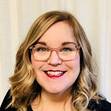Amy Sue Nathan's Blog: Women's Fiction Writers, page 9
December 14, 2017
The Worst Thing You Can Ask Me About My Book
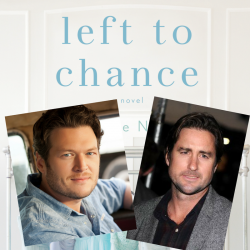 The best compliment I’ve been given about Left to Chance is that readers want to go there. Yes, to Chance, Ohio. To a fictional town in the corner of a state I lived in once for ten months (and in real live Cleveland, not charming Chance).
The best compliment I’ve been given about Left to Chance is that readers want to go there. Yes, to Chance, Ohio. To a fictional town in the corner of a state I lived in once for ten months (and in real live Cleveland, not charming Chance).
Readers want to go to Perk for coffee, and most of them want to meet Beck. He’s my favorite too although my agent and I agree to disagree on whether he looks like Luke Wilson or Blake Shelton.
I don’t mind discuss the virtues of Beck’s appearance, but between you and me, it’s also the worst question someone can ask.
If you’re familiar with my m.o., I don’t see the faces of my characters when I write. Therefore, when people want to know who I *see* in the roles of the characters should it ever become a movie, I head straight to Google. Because NO CLUE.
And that’s not because I don’t watch movies or TV. I watch way too much of all of it. But it’s things like mannerisms and inflections and style that captivate me. Not faces.
To be honest, there’s usually ONE that pushes its way through with each book, so I start there. In The Glass Wives, Laney was always Andie Macdowell, yet to this day I’ve never seen the face of the main character, Evie Glass.
In The Good Neighbor, Mrs. Feldman was always a combination of Betty White, Bea Arthur, and some of my elementary school teachers who I used to think were old but were likely in their early sixties when they taught me in the early seventies.
In Left to Chance I always saw Beck as Blake Shelton, but maybe that was just a way for me to work Blake Shelton into my workday since I can’t write with music.
I’m grateful to the bloggers and readers who cast my novels for me. I don’t know if it’s easy for them or if they look at it as a challenge. Either way, it’s always fascinating to see faces attached to the characters I invented. Still, they never look “quite right” to me, though if someone wants to make a movie from one of my books, I promise I’ll come around quick! Strangely, aside from the financial aspect of a deal like that, it has never appealed to me much. I like the way each reader creates faces and places in her head, only helped along by what I’ve written. I learned when The Glass Wives was published that I cannot sit with every reader and tell her what I meant or was intended. Each reader brings her own history (baggage, if you will) into a reading experience and makes it her own.
So if you ask me Luke or Blake, the answer will always be: you decide. (And let me know!)
xo,
Amy
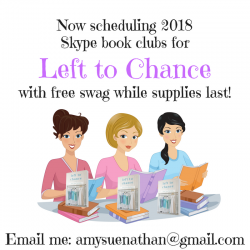
November 19, 2017
That Time My Son Interviewed Me About My Novel, Left To Chance
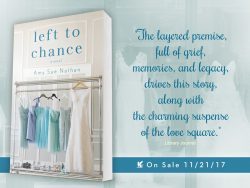 Full disclosure: Mom gushing below because today’s interview is brought to you by genetics.
Full disclosure: Mom gushing below because today’s interview is brought to you by genetics.
It’s been a tradition here at Women’s Fiction Writers to have someone interview me to celebrate the publication of one of my novels. Eleanor Brown interviewed me for The Glass Wives. Patti Callahan Henry interviewed me for The Good Neighbor.
Today, I’m being interviewed by Zachary Gropper, my twenty-five-year-old son. (This is the gushing part) He lives in Manhattan, is the Brand Manager for a tech start-up, and is a graduate of Indiana University. Let’s add that he calls me on regular basis and comes to visit if I ask, and sometimes when I don’t. He remembers my birthday. He’s smarter and funnier than me. He answers my texts. I’m so proud of the man he has become I usually have to be told to shut up. (Okay, shutting up now.)
He also took my current author photo. You know, the one on the back of the book, as well as some of the more flattering photos you see online.
I hope you enjoy these bits of insight into Left to Chance, and my family. If we’ve piqued your interest, I hope you’ll add the novel to your shopping list! Here’s a link to Amazon: Left To Chance.
xo,
Zachary’s Mom
That Time My Son Interviewed Me About My Novel
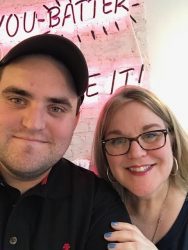
Zachary & Zachary’s Mom in NYC, 2017
Zachary: At what point during the process of writing and publishing LTC did you first know you were on to something that felt really special?
Zachary’s Mom: I think I realized this story had a spark when I felt like I was Teddi, the main character, when I was writing. If it was so natural for me to slip into her shoes, I had a feeling she’d be very relatable to readers. Early readers seem to agree!
Zachary: Was there a point that stands out as the toughest or most challenging?
Zachary’s Mom: Well, you can ask your sister! I had a little problem with the pacing of the story, and at first had everything happening in the first two days, which took up half the manuscript. Chloe and I read the story aloud, wrote scenes on colored index cards, laid them out on the dining room table, and rearranged them until the story was balanced. It took HOURS.
Zachary: Are there lessons you’ve learned that could affect your writing in the future?
Zachary’s Mom: I’m making sure that my new book’s calendar (which I call book math) is set and organized ahead of time. In my new little apartment I don’t have room for all those index cards. My work-in-progress also has two timelines, so I think it’s even more crucial for me to have the pacing worked out ahead of time. I like to think I don’t make mistakes twice — I go ahead and make all new kinds of mistakes!!
Zachary: Overall as an author, how much do you think you’ve changed or evolved since each of TGW and TGN were published?
Zachary’s Mom: I think my expectations are more realistic when it comes to publicity, and that’s definitely something that has evolved.. It takes a lot of time and effort to get the word out about a book, because there are so many good books out there to choose from. Making mine stand out from the rest is part social media, part publisher marketing and publicity, and part pixie dust. With regard to writing, I think I’m more deliberate in my story telling, even though I allow things to evolve as I write. I know ahead what needs to be accomplished, and why, much more so than with my earlier books.
Zachary: If you were speaking to someone who hasn’t read your writing before, why should they want to read LTC?
Zachary’s Mom: I feel as if I’ve created a small town readers would want to visit with characters they’d like to be friends with. Plus I wrote in an adorable coffee shop I wish I could go to. You know how important my coffee is to me.
Zachary: At your last launch event, there were cupcakes with frosting matching the colors of TGN book cover. How much did cupcake planning impact cover art decisions this time around?
Zachary’s Mom: You know me well! It’s hard for me to pass up the opportunity to color coordinate or to embrace a good theme! This year we’re having wine and chocolate so I’d say the theme is DELICIOUS! Everyone’s invited!
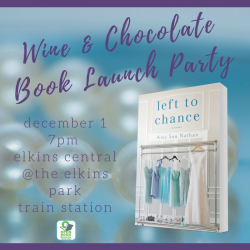
7878 Spring Avenue, Elkins Park, Pennsylvania
Did you really think I wouldn’t post a picture of little Zachary?
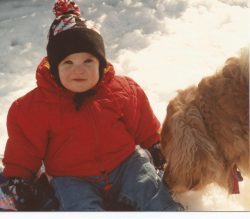
Baby Zachary and our first of four family dogs, Einstein. Winter 1992, Maplewood, NJ
If you liked this interview, please share!
November 17, 2017
Picking Favorites: Which One Of My Novels Do I Like Best?

Oh, I am so sorry I’ve been MIA! I forgot how much work it is to get ready to launch a novel, to write another novel, and to be a freelance editor and book coach. Add in some nervousness and excitement and some things just fall to the side. Like laundry. Oh, the clothes are clean, but in a pile. Grab and go. That’s me.
I hope that’s you too, and that you’ll grab a copy of Left to Chance either with a pre-order or when it goes on sale on Tuesday! All the links are right here.
In addition to Left to Chance arriving in bookstores and online on Tuesday, my daughter will be arriving for Thanksgiving! I can’t think of a better way to celebrate.
And, if you’re in the Philadelphia area please help me celebrate Left to Chance by stopping by to say hi at one of these signings or events!

Between you and me, this is my favorite book of the three I’ve had published. Each one has a lot of meaning because of all the work that went into it, but Left to Chance ended up to be the most personal, which is odd considering it’s the first book I’ve written that does not have a morsel of my own life at its core. Weird, right? Teddi’s shoes were the easiest to slip into, and I felt like I was Teddi when I was writing. It was almost a virtual reality experience for me when she walked through her hometown, when she sat on the steps of her best friend’s childhood home, and when she stood outside the town’s cemetery, afraid to go in, even though in real life, I am not afraid, or even wary of, cemeteries.
I especially enjoyed writing what’s been deemed “the love square” not only by my literary agent but by Library Journal.

So, what’s a love square? It means that Teddi’s emotions are tangled up with three men. One she used to love, one she thinks she loves, and one she thinks she could love. That being said, this is not only a love square but squarely women’s fiction. Teddi gets into messes and out of them, on her own. She faces her fears, her misgivings, and makes decisions that are best for her. And she has some really cool women friends in the mix.
Hey, I guess that part is like me. I have some awesome women friends (and I count many of you among them).
I’ll be back to tell you more about Left to Chance!
Amy xo
Do you follow me on Instagram? @AmySueNathan
October 30, 2017
Author Interview: Janet Benton Spent 8000 Hours Writing Lilli de Jong
When I moved back to the Philadelphia area about a year ago (time flies, right?) I didn’t know so many of my neighbors would be writers — but it seems to be true.
One such neighbor is Janet Benton, whom I had the pleasure of meeting not long after I arrived, and right before the publication of her debut novel, Lilli de Jong.
What I love about interviewing and talking to authors is how ever journey is unique, but when we’re fortunate, we all end up in the same place, one where we’re holding a published novel.
Please welcome Janet Benton to Women’s Fiction Writers. Tell us in the comments: do you know how many hours you’ve worked on your novel(s)? For me, that’s akin to book math, so I’m inclined to go with a lot. 
October 5, 2017
Author Interview: Heather Webb & Hazel Gaynor Co-Author A New WWI Novel
If you’ve been reading this blog for a while you know I adore epistolary novels, and now I have a new one to share with you.
Last Christmas in Paris by Hazel Gaynor and Heather Webb has just hit bookshelves and it’s a don’t-miss historical novel set during World War I that follows Evie Elliot through her personal experiences and correspondences, mostly with her brother’s best friend, Thomas Harding. I’ll be honest, there were times I forget this was fiction and that I wasn’t just reading old letters someone had discovered in an attic.
It’s a layered story, deftly handled, and when I think it was written by two authors, not one I’m intrigued and impressed.
I think you will be too!
Please welcome Hazel and Heather to WFW!
Amy xo
Author Interview Heather Webb and Hazel Gaynor on LAST CHRISTMAS IN PARIS
http://womensfictionwriters.com/wp-content/uploads/2017/10/LCIP_IG.mp4
Amy: Heather and Hazel, I’m so excited because this is truly a two-fer! One, I loved Last Christmas in Paris, and two, I get to interview two authors!!
H & H: Thank you for both, Amy! You’re very generous with other authors!
Amy: Let’s start at the very beginning. How did you meet?
H & H: We were first introduced through our mutual agent in 2013. She thought we’d hit it off and could help each other navigate the dangerous publishing waters together as debut authors. She was so right! We’ve become great friends.
Amy: Would you share with us the journey of deciding to write this novel together?
H & H: Sure! We were acquaintances for a couple of years before we collaborated in 2015 on the WWI anthology, Fall of Poppies: Stories of Love and the Great War. In writing that book, we realized we shared not only a love of history and writing, but a sense of humor, family life, and a love of good food and wine. We also both felt there was more we wanted to write about WWI and a frantic brainstorming session quickly led to the idea of writing a book together. But how? Especially when you factor in the added complication of us living on different continents and working in different time zones. An impossible task? Perhaps on paper. But we were ready to take up the challenge.
Amy: You’re both historical fiction authors — well, I’m dipping in my toes with a historical element in my fourth novel. What about the time period of WWI drew you to it? What draws you to any particular time in history enough to write a novel about it? Is it a person, a place? (Feel free to share examples and name your other books)
Heather: I first became interested in WWI in my Early Twentieth Century French Literature class in college–sounds riveting, I know, but it really was! That interest festered somewhere in the background for me because there were so few books published set during that time and few television shows or films…it sort of faded away. Until Downton Abbey. That amazing show blazed onto center stage and it all flooded back for me. Its popularity spurred a whole new wave of novels set during this incredibly important period of history. An era filled with inventions and women’s rights and the complete dismantling of society’s structured class system. Oh, and the clothes! THE CLOTHES! I wish we still dressed like this. This wave of renewed interest sparked the idea for Fall of Poppies as mentioned above.
In terms of what draws me to a period in general? I have my favorites– French Revolution, and 1850s up through WWI (the Romantic era, followed by the Gilded Age and Edwardian era)—but I can be sold on any era if there’s a great story and a great character at hand. I’m a real sucker for interesting facts that stand out because of their oddity or beauty, or those that surprise modern readers.
Setting and a sense of place, or belonging (or not belonging!) is a huge theme in my novels. In my novel Becoming Josephine, we have a young woman who leaves her poor sugar plantation in the Caribbean for the erudite salons of Paris. Talk about a fish out of water! I really enjoyed depicting her rise to empress of France, and all the detailing that went into constructing the French Revolution on the page. In my second novel, Rodin’s Lover, we have a young sculptress who leaves her country home for Paris to make her way in the male-dominated art world. Paris was the place to be as an artist during the Gilded Age, or as the French call it, the Belle Époque. Again, I show a woman questioning her worth and identity in circles she doesn’t seem to be able to fit into. I guess you could say, I’m inspired both by location/era and also by ordinary people doing extraordinary things in the past that lay the groundwork for our present day. My current work in progress is set in 1900 U.S., and these themes—along with finding trust and love—are prevalent once again.
Hazel: It’s funny because WW1 had never really appealed to me as a writer, mostly because I associated it with military battles and trenches and a very male experience, but in writing my 1920s set novel The Girl From The Savoy, I had to research the war to understand how ordinary young women and men had been affected by it and to give my characters an authentic back story. At the same time, Heather approached me about Fall of Poppies so the two projects soon had me fully immersed in the war and I found it fascinating. So much so that I wanted to write about it in more depth – as did Heather. Cue, Last Christmas In Paris! WW1 was such a life-changing event and it offers a very powerful starting point for a novel.
I partly covered the war again in my other current release, The Cottingley Secret, because while the novel is about a famous hoax concerning photographs of fairies, the events of the novel take place in England during 1917-1921, so again, it was important to acknowledge the impact the war had on my characters.
My novels are mostly set within the past 100 years and it is always a real historic event, or place which first inspires me. For example, I’ve written about the Titanic (The Girl Who Came Home), flower sellers in Victorian London (A Memory of Violets) and the roaring ’20s (The Girl From The Savoy). Historical fiction requires a deep passion for the subject in order to do the necessary research to lend your writing authenticity. I absolutely love it!
Amy: I am a fool for epistolary novels. What was the biggest challenge in writing a novel in letters?
H & H: There were two big challenges. One, it was difficult to explain events happening around the characters in the midst of war without going off on a long jag of information that feels dumped and unnatural in the midst of the story. Two, pacing is crucial in any novel and we had to figure out how to build a climax without properly fleshed out scenes. We’re hoping we managed it well!
Amy: I’m sure you’ve answered this a gazillion times, but what was your process for writing his novel as a team?
H & H: Hazel would wake up in Ireland and pen a letter or two from her character. Several hours later, Heather would wake in the U.S. to find mail in her inbox, and write a reply from her character, and so on. We’ve often described it as waking up to a writing prompt each day. The process felt very organic, and the story flowed. Editing, on the other hand, was a more tricky operation. We used comment bubbles and colored fonts to track our changes, and somehow, with plenty of Skype chats and coffee, it all came together.
Amy: What’s your best advice for aspiring authors, or maybe sometime new to writing historical fiction (self-serving question, for sure).
Heather: My best advice for new writers is to take your time to get it right. We feel all of this pressure to rush and submit our work for validation. That rush short-changes us in the long run. Write, rewrite, work with critique partners. Get as many eyes on your work as possible. Read like crazy and STUDY what you read, Dissect it like a science experiment. Why does it work? How can you replicate this technique? Also, if you become frustrated with your work in progress, put it aside awhile and let it stew. Work on something new. You’ll find you learn best by working on more projects, over longer periods of time. Remember that writing is a skill, just like playing a guitar. Time and practice are key. You can’t rush it or it’ll sound like crap.
Hazel: My advice is to finish what you start. The world is littered with abandoned novels. We all struggle after that first flurry of excitement. You just have to push on through! Also, I encourage aspiring authors to understand that in the first draft you are telling yourself the story, so don’t worry about making it perfect. Subsequent drafts (of which there will be many!) are where you do the real writing, restructuring and polishing. Just get that first draft down so you have something to work with. And enjoy it. A debut novel is the only novel you will write without a deadline or distraction of other books to promote. Throw your heart and soul into it and it will shine through on the page.
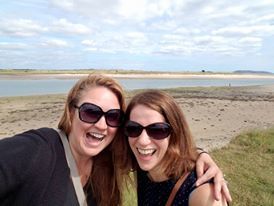 Hazel Gaynor is the New York Times and USA Today bestselling author of The Girl Who Came Home and A Memory of Violets, and the recipient of the RNA Historical Novel of the Year award 2015. Her latest novel, The Cottingley Secret, released this summer. She lives in Ireland with her husband and two children. For more information, find her at: www.HazelGaynor.com, or @hazelgaynor on Twitter, Instagram, and Facebook.
Hazel Gaynor is the New York Times and USA Today bestselling author of The Girl Who Came Home and A Memory of Violets, and the recipient of the RNA Historical Novel of the Year award 2015. Her latest novel, The Cottingley Secret, released this summer. She lives in Ireland with her husband and two children. For more information, find her at: www.HazelGaynor.com, or @hazelgaynor on Twitter, Instagram, and Facebook.
Heather Webb is the nationally acclaimed author of historical novels Becoming Josephine and Rodin’s Lover. In 2015, Goodreads selected Rodin’s Lover as a Top Pick. To date, her novels have sold in multiple countries, worldwide. In addition to novel writing, Heather enjoys working with aspiring writers as a professional freelance editor. She is a member of the Historical Novel Society and lives in New England with her children and husband, and one feisty rabbit. For more information, find her at: www.HeatherWebb.net, or @msheatherwebb on Twitter, Instagram, and Facebook.
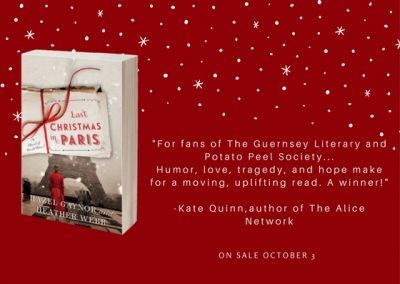
September 27, 2017
The Secret To Writing A Novel
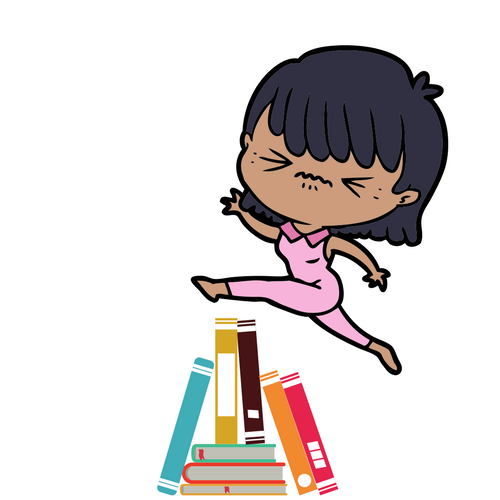 Think of your dead stops as hurdles, not walls.
Think of your dead stops as hurdles, not walls. As I stared at the monitor I knew, in the deepest part of my writer’s heart, that the chapter I’d just written, sucked.
The writing didn’t suck, mind you. The insights were fresh, the main character was witty in the right places. I’d layered in the right amounts of atmosphere, backstory, and subplot, but not too much. The dialogue was well-paced. The cadence sounded right to my ear.
But none of it helped the story move forward.
No matter how many ways in however many days I rewrote that chapter, it didn’t work. It was as if I’d wrapped a string around my story and then pulled, and it and spun around and around and around like a top, and dropped in the same place it started. What I need was one of those toy guns that shoots suction cup darts.(And I am anti-gun, but drastic times, and all that.) I would just pull the trigger and the suction cup would fly forward and stick.
But I didn’t have a dart gun, I had a sucky chapter.
If I looked at this as a wall (or something like writer’s block, which I don’t buy into), there would be no way to move it, go under it, over it, or around it. So I chose to see it as a hurdle.
Hurdle: an upright frame, typically one of a series, that athletes in a race must jump over.
Just call me a fiction Olympian.
I followed advice from a friend and set up a new document so none of my changes would effect what I’d already done, just in case. Then I knew what I had to do. I wrote the next chapter all over again, from scratch, ditching notes, cards, and outlines. I swept my brain clean of preconceived ideas and notions (and oh, how I love my notions, and the word notions, but I digress…) And I wrote from another point of view. This was not an easy decision, as I felt as if I was cheating on my main character and our vision for the story. It took me days to have the guts to do it. I don’t even know if that will stay in the story but it worked to move the story forward. I have a dart that sticks. For now. (They fall eventually, you know that, even if you lick them. Don’t say eww, you know you were thinking it.)
The leap over the hurdle doesn’t have to be something you’d ever do again, it just has to work once, to get you to that other side.
If you have ever wondered if novel writing gets easier, the answer is no.
For me it has grown increasingly challenging, but I find that the higher the hurdle, the louder the cheers (in my own head) when I stick the landing.
How have you gotten over some of your writing and story hurdles? Did you turn any of them into walls and now wish you hadn’t?
Amy xo
In case you missed it, THE GOOD NEIGHBOR ebook is currently $1.99 across all platforms like Kindle and Nook!
http://womensfictionwriters.com/wp-content/uploads/2017/09/promo-MyPromovideo.mp4
September 26, 2017
$1.99 ebook deal – THE GOOD NEIGHBOR
To celebrate the upcoming launch of Left to Chance, St. Martin’s Press has a deal for you! The ebook of The Good Neighbor is just $1.99 for a limited time, anywhere you buy your ebooks!
If you signed up for my Infrequent Yet Delightful Newsletter you’ve received a link to read the first two chapters of Left to Chance! If you haven’t signed up, leave your email below and I’ll get the current issue out to you, and make sure you don’t miss another! Or sign up on the handy-dandy drop-down! (Which I designed myself, thankyouverymuch.)
Amy xo
http://womensfictionwriters.com/wp-content/uploads/2017/09/promo-MyPromovideo.mp4
KINDLE
NOOK
September 20, 2017
Author Interview: Kaira Rouda’s BEST DAY EVER, Plus Advice To Never Give Up
It feels fabulous to kick a Fall full of interviews with my friend, Kaira Rouda. She’s the author of Best Day Ever, and while it’s a domestic thriller, I consider strongly how it also falls under the Women’s Fiction umbrella — and when you read it, I think you’ll agree.
I know many people balk at the label women’s fiction, but I find it more inclusive than exclusive.
As you’ll read below, I was lucky to read an early copy of Kaira’s novel. I don’t know that I’d be reading these page-turning thrillers if my author pals weren’t writing them, so I have to say, LUCKY ME. I’ve stretched my reading muscles lately.
Kaira shares her story, her journey, and some writing advice below. Please welcome her to WFW!
Amy xo
BESTSELLING AUTHOR KAIRA ROUDA AUTHOR INTERVIEW FOR BEST DAY EVER
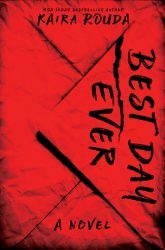 Amy: I don’t bite my nails but I found Best Day Ever to be a nail biter, along with a story that evoked a lot of compassion. Besides the obvious psychological suspense, what was “the point” of the story for you when you were writing it? Or wasn’t there?
Amy: I don’t bite my nails but I found Best Day Ever to be a nail biter, along with a story that evoked a lot of compassion. Besides the obvious psychological suspense, what was “the point” of the story for you when you were writing it? Or wasn’t there?
Kaira: I’m glad you don’t bite your nails, but I do hope BEST DAY EVER caused you to flip the pages quickly. Dark women’s fiction, and in this case psychological suspense, is about entertainment, and that in itself is the point. My traditional women’s fiction novels also – hopefully – entertain, but they do have more of a point. HERE, HOME, HOPE was about a woman overcoming her midlife crisis, and IN THE MIRROR was about a young mom facing a serious cancer diagnosis, while THE GOODBYE YEAR tackled a mom’s impending empty nest. But when it comes to suspense, I believe “the point” takes a backseat to the plot. At least it does for me. In my first suspense novel, ALL THE DIFFERENCE, there is a black widow on the loose and the point is will she be discovered before she murders again. In BEST DAY EVER you know from page one Paul Strom isn’t what he seems. The point of the story is the plot: what is he up to and will he get away with it. That being said, I hope there is a bit of poetic justice and empowerment in the pages that could be “the point”. But I certainly wrote this story with plot progression as the primary point. What secrets are unveiled when and how? That’s the fun of writing psychological suspense – and hopefully the fun in reading it, too.
Amy: I’m sure many readers are talking about Paul, one of your protagonists. I’d like to talk about Mia. What or who inspired her character?
Kaira: Thank you for asking about Mia! You’re right, she isn’t the person most people discuss or write reviews about after reading BEST DAY EVER. Paul is so overpowering, so creepy, that Mia, his wife, is a bit in the shadows. Mia’s character is inspired by women who have realized they are in a bad relationship and find the courage to get out. We all know these stories, perhaps it is an unfortunate part of our own life story. The perfect man isn’t who he seems. Mia’s quiet strength is her character’s finest quality. When I tried to figure out how Paul appeared in my subconscious, demanding I write his story, I realized he was inspired by the terrible bosses I endured over my journalism and marketing career. Mia represents successfully rising above them.
Amy: Are there plans for a sequel? And that’s from someone who doesn’t usually read sequels (but would read this one).
Kaira: Paul absolutely wants a sequel. I probably sound crazy but he is such a strong, dominant force that he’s still in my head even as I wrote book two. Of course, he’s hanging out in Palm Beach, dating wealthy widowers, waiting for his chance to return. We shall see! Thanks for saying you would read it! I’d love to write it.
Amy: Previous novels of yours would fit under the women’s fiction umbrella, and I see how this one would as well, though it’s clearly a thriller. What are your thoughts on crossover appeal and genre?
Kaira: Women’s fiction is about relationships and growth, so yes, BEST DAY EVER could be considered women’s fiction. It’s funny. I’ve now written a nonfiction book for women entrepreneurs, two romance series, launched a Kindle world, and written three women’s fiction and two suspense novels. My first novel came out six years ago, and since then, I haven’t followed a traditional publishing or writing path. And I’m glad. I know there are some people who will never read a romance novel, and some readers who are disturbed by psychological and domestic suspense. But I also know there are people, like me, who read widely and broadly, readers who have followed me across genres and I’m so thankful for their support. This novel, BEST DAY EVER, is unique for me because it’s my first “big publisher” book. I was thrilled when my editor acquired it to lead the new Harper Collins/Harlequin imprint, Graydon House. When she called and told me it would be out in hardcover I truly couldn’t believe it. The support they’ve put behind this title has been a once-in-a-lifetime, dream come true for me as an author. I hope we have a long publishing life together in dark women’s fiction.
But that doesn’t mean I haven’t had a great journey with small press and indie publishing. I have. I’ve learned so much, and met so many fabulous authors along the way, in numerous genres. This can be a lonely career, but with social media I can reach out and stay connected to my fellow women’s fiction, romance, thriller authors. I love that.
So do people read cross-genre? Yes. Has the advent of ebooks made it easier for people to discover similar titles as well as popular books in other genres? Absolutely. I don’t have a pen name and that was a conscious decision. I am who I am, and so far, I’ve been able to write what I like. One of my first favorite authors is Susan Isaacs. She inspired the first books I ever wrote, and I believe her novels are the reason why Paul Strom exists. This is my favorite genre, and I’m thrilled (pun intended) to be writing in this suburban suspense space again. I hope to stay awhile.
Amy: What’s the best writing advice you can share with aspiring women’s fiction authors?
Kaira: Don’t give up.
Finish your manuscript. Polish it. Attend writer’s workshops and conferences. Try to sign with an agent, but if you don’t land one, self-publish. Repeat. Or don’t. Some authors find amazing success self-publishing and you may be one of them. No matter what your journey becomes, do not belittle others on a different path. It irks me beyond measure when “traditionally” published authors put down “self-published” or indie authors. Come on people. We’re all in this together and you just never know when you’ll be one, and then the other. So, aspiring authors, be kind and supportive to every author you meet on your journey. Go write a positive review.
Personally, I think each book has its own journey, its own destiny so to speak. Sure, there are people out there with huge brands, continual contracts, gigantic marketing support from their publishers, but those authors are the exceptions. For most of us, it’s a book-by-book journey. Publishing is fickle. We’re in a creative business folks. Success should be measured by your personal satisfaction in writing the best story you can write, not by how big the imprint or advance is. The options for you to get your book into readers’ hands have never been more plentiful. Be open to them all.
And most importantly, don’t give up.
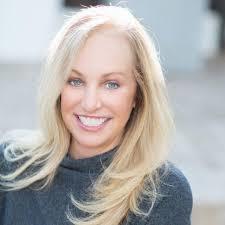 Kaira Rouda is a USA TODAY bestselling, multiple award-winning author of contemporary fiction exploring what goes on behind closed doors of seemingly perfect lives. Her novels include BEST DAY EVER, ALL THE DIFFERENCE, HERE, HOME, HOPE, IN THE MIROR and THE GOODBYE YEAR. Her modern romance novels are set on beaches, including the Indigo Island series and the Laguna Beach series, also its own Kindle World.
Kaira Rouda is a USA TODAY bestselling, multiple award-winning author of contemporary fiction exploring what goes on behind closed doors of seemingly perfect lives. Her novels include BEST DAY EVER, ALL THE DIFFERENCE, HERE, HOME, HOPE, IN THE MIROR and THE GOODBYE YEAR. Her modern romance novels are set on beaches, including the Indigo Island series and the Laguna Beach series, also its own Kindle World.
She lives in Southern California with her family and is at work on her next novel. Connect with her on Twitter, Instagram and Pinterest: @KairaRouda; and on Facebook at Kaira Rouda Books. For more please visit wwww.KairaRouda.com.
September 11, 2017
Strange Things That (Only) Happen To Novelists
I have a strong connection to my WIP. Some might say it’s an unnatural connection. You be the judge.
As committed as I am to launching Left to Chance, and as devoted as I am to Teddi Lerner and her love square (not a triangle! a square!) there is just something about South Haven, Michigan and Boop Peck that has captured my heart and my imagination more so than ever before. That doesn’t mean it’s been easy. I’m trudging through a chapter now and can’t quite settle on the players or the events. Yes, I’ve worked the Story Genius method with scene cards. Yes, I’ve outlined. Yes, I’ve brainstormed. I just keep changing my mind as to what works.
But today I sitting on my new comfy couch with my laptop, determined to polish ONE SCENE. Not a chapter. A scene. Hell, I’ll settle for a polished paragraph. I’m not even finished yet, it’s 7:30pm, and I’m getting a hunger headache, but I’m not stopping until that one scene is sparkly, at least for the moment. (Edited to add: I stopped mid-blog-post and had a veggie burger. With cheese. Headache averted.)
Part of that scene is a short paragraph, just a few lines, of a flashback for eighty-four-year-old Boop. She’s planning to bake what she calls a “talking cake” for her granddaughter, Hannah. (A cake made so that she can have a serious talk with her granddaughter.) This day, Boop’s going to make her own version of her grandmother’s lemon blueberry cake. South Haven is famous for its blueberry farms, and Boop remembers some important details of a long ago summer day of picking blueberries with her first love. It’s a lovely flashback if I do say so myself. I wrote it and was satiated. It was sweet and meaningful in the past and in the present story.
Within a moment of finishing the passage, I rose from the sofa to get a drink, opened the fridge, and these spilled out. I just stared. For about twenty seconds. I just stared.

Coincidence? Cosmic forces?
I’m going with the latter, at least for now.
What weird things have happened to you while you were writing fiction? This is only one of a few that go along with writing The Last Bathing Beauty. But there’s plenty of time for more stories.
And maybe it was just the universe telling me to wrap things up with Boop and get on with the posts about Left To Chance. It’s eighty days until book launch. Not that I’m counting. 
August 30, 2017
September Writing Goals and a LEFT TO CHANCE ARC Giveaway
It’s three months until the publication of Left to Chance, and I’m giving away the last ARC to someone who is subscribed to my **New and Improved** Infrequent But Delightful Reader Newsletter. It’s different from the blog, so I hope you’ll give it a go!
Here’s the link if you missed the big sign up the fell on the blog when you opened it. 
Women's Fiction Writers
- Amy Sue Nathan's profile
- 543 followers


